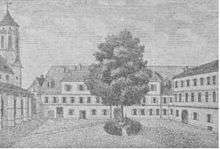South Slavic Bible Institute
 The seat of the South Slavic Bible Institute: 1910 drawing of the castle (former convent) of Amandenhof | |
| Founder(s) | Hans von Ungnad |
|---|---|
| Established | January 1561 |
| Mission | to spread Protestantism among all South Slavs through printing liturgical books in Glagolitic, Latin, and Cyrillic script |
| President | Primož Trubar |
| Staff | Stjepan Konzul Istranin, Antun Dalmatin, Jovan Maleševac and Matija Popović |
| Key people | Hans von Ungnad |
| Location | former convent of Amandenhof, Urach, Habsburg Monarchy |
| Dissolved | 1565 |
The South Slavic Bible Institute[1] (German: Südslawische Bibelanstalt)[2] was established in Urach (modern-day Bad Urach) in January 1561 by Baron Hans von Ungnad, who was its owner and patron.[3] Ungnad was supported by Christoph, Duke of Württemberg, who allowed Ungnad to use his castle (former convent) of Amandenhof near Urach[4] as a seat of this institute.[5]
Baron Ungnad was interested in Protestant proselytism propagated by Primož Trubar and attended the session of German theologians held in Tubingen in 1561.[4] At that occasion Ungnad, probably instructed by Duke Christoph, agreed that he would take responsibility for publishing Slavic books.[4]
Within the institute, Ungnad set up a press which he referred to as "the Slovene, Croatian and Cyrillic press" (German: Windische, Chrabatische und Cirulische Trukherey).[3] The manager and supervisor of the institute was Primož Trubar.[3] The books they printed at this press were planned to be used throughout the entire territory populated by South Slavs between the Soča River, the Black Sea,[6] and Constantinople.[7] Trubar had idea to use their books to spread Protestantism among Croats and other South Slavs.[8] For this task, Trubar engaged Stjepan Konzul Istranin and Antun Dalmatin as translators for Croatian and Serbian.[9] The Cyrillic text was the responsibility of Antun Dalmatin.[10] The type for printing the Cyrillic-script texts was cast by craftsmen from Nuremberg.[11] The first attempt to use it failed, and the type had to be reconstructed.[5] In 1561 in Tubingen three small books were printed (including Abecedarium and Catechismus) on Croatian language[12] with Glagolitic script. The same books were also printed in Ulach on Serbian language with the reconstructed Cyrillic type.[5][12] Juraj Juričić worked as a copy reader at the institute from 1562 to 1563.[13]
Language used by Dalmatin and Istranin was based on northern-Chakavian dialect with elements of Shtokavian and Ikavian.[14] People from the institute, including Trubar, were not satisfied with translations of Dalmatin and Istranin.[14] Trubar and two of them exchanged heated correspondence about correctness of the language two of them used even before the first edition translated by Dalmatin and Istranin was published and immediately after it.[15] For long time the institute tried to engage certain Dimitrije Serb to help Istranin and Dalmatin, but without success.[16] Eventually, they managed to engage two Serbian Orthodox priests, Jovan Maleševac from Ottoman Bosnia and Matija Popović from Ottoman Serbia.[16]
This institute and its press were operational until Ungnad died in 1565.[7]
References
- ↑ Betz 2007, p. 54.
- ↑ Vorndran 1977, p. 8.
- 1 2 3 Society 1990, p. 243.
- 1 2 3 Review 1988, p. 388.
- 1 2 3 Breyer 1952, p. 32.
- ↑ Črnja 1978, p. 117.
- 1 2 Klaić 1974, p. 71.
- ↑ Rotar 1988, p. 17.
- ↑ Lubotsky, Schaeken & Wiedenhof 2008, p. 280.
- ↑ Društvo 1972, p. 595.
- ↑ Sakcinski 1886, p. 103.
- 1 2 Balkanologie 1977, p. 147.
- ↑ Slovenski biografski leksikon: Jurij Juričič.
- 1 2 Mošin & Pop-Atanasov 2002, p. 18.
- ↑ štamparija 1922, p. 261.
- 1 2 Матица 1976, p. 112.
Sources
- Society (1990). Slovene Studies: Journal of the Society for Slovene Studies. The Society.
- Črnja, Zvane (1978). Kulturna povijest Hrvatske: Temelji. Otokar Keršovani.
- Betz, Hans Dieter (30 June 2007). Religion past and present. Brill.
- Klaić, Vjekoslav (1974). Povijest Hrvatâ od najstarijih vremena de svršetka XIX stoljeća. Matica hrvatska.
- Breyer, Mirko (1952). O starim i rijetkim jugoslavenskim knjigama: bibliografsko-bibliofilski prikaz. Izdavački zavod Jugoslavenske akademije znanosti i umjetnosti.
- Lubotsky, Alexander; Schaeken, J.; Wiedenhof, Jeroen (1 January 2008). Evidence and Counter-evidence: Balto-Slavic and Indo-European linguistics. Rodopi. ISBN 90-420-2470-4.
- Sakcinski, Ivan Kukuljević (1886). Glasoviti hrvati proslih vjekova: niz zivotopisa. Naklada "Matice hrvatske".
- Review (1988). The Slavonic and East European review.
- Vorndran, Rolf (1977). Südslawische Reformationsdrucke in der Universitätsbibliothek Tübingen: e. Beschreibung d. vorhandenen glagolit., kyrill. u. a. Drucke d. Uracher Bibelanst. Franz Steiner Verlag. ISBN 978-3-16-939761-7.
- Društvo (1972). Bibliotekar. Društvo bibliotekara N.R. Srbije.
- Rotar, Janez (1988). Trubar in Južni Slovani. Državna zal. Slovenije.
- Mošin, Vladimir A.; Pop-Atanasov, Ǵorgi (2002). Izbrani dela. Menora.
- Матица (1976). Review of Slavic studies. Matica srpska.
- štamparija (1922). Prilozi za književnost, jezik, istoriju i folklor. Drzhavna štamparija Kralevine srba, khrbata i slovent︠s︡a.
- Balkanologie (1977). Zeitschrift für Balkanologie. R. Trofenik.